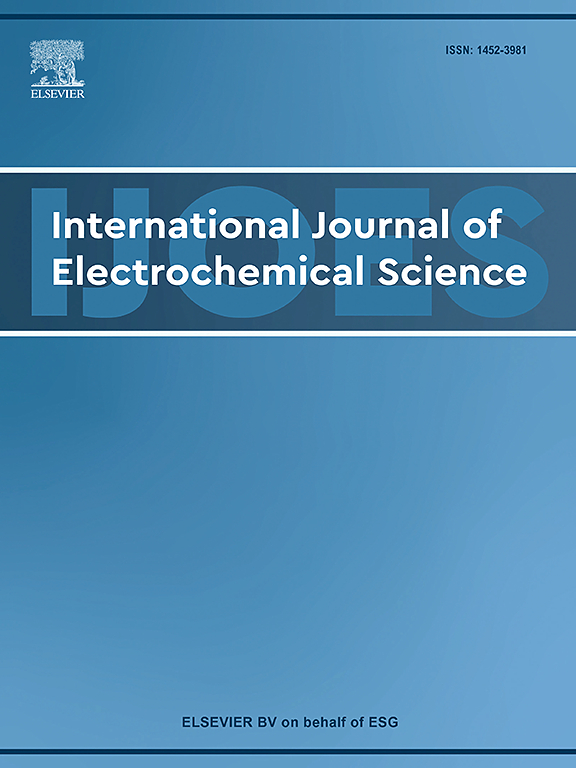Application of chitosan/ZnTiO₃ nanocomposite as an electrochemical sensor for vitamin D detection in dairy products
IF 2.4
4区 化学
Q4 ELECTROCHEMISTRY
International Journal of Electrochemical Science
Pub Date : 2025-08-06
DOI:10.1016/j.ijoes.2025.101148
引用次数: 0
Abstract
Vitamin D deficiency is linked to osteoporosis, cardiovascular diseases, and immune dysfunction, making rapid detection crucial for clinical and nutritional management. In this work, a novel immunosensor for determining the presence of vitamin D3 (V-D3) is developed and validated utilizing an electrode modified with a bovine serum albumin and vitamin D3 antibody, which is made of zinc titanate (ZnTiO3) and chitosan nanocomposites on a glassy carbon electrode. The immunosensor exhibited a wide linear range from 1 to 870 ng/mL and a low detection limit of 0.071 ng/mL with high sensitivity (0.1139 µA/ngmL−1). The repeatability test indicated no change in more than 15 successive measurements, and the value of the relative standard deviation (RSD) of the reproducibility tests was obtained to be 3.52 %. The immunosensor showed high selectivity in response to V-D3 and low interference by common blood proteins and metabolites. Spiking materials gave recovery between 86.64 % and 93.50 %, RSD ≤ 4.81 %, which also demonstrated perfect agreement with immunosorbent enzyme-linked assay (ELISA) in real samples of human blood and dairy products. The measurement of vitamin D in food samples is important to monitor the amount of intake and the risk of deficiency, which associates with a variety of health problems. These results illustrate the potential of clinical diagnosis and food safety monitoring with the immunosensor.
壳聚糖/ZnTiO₃纳米复合材料在乳制品中维生素D检测中的应用
维生素D缺乏与骨质疏松症、心血管疾病和免疫功能障碍有关,因此快速检测对临床和营养管理至关重要。在这项工作中,开发了一种用于测定维生素D3 (V-D3)存在的新型免疫传感器,并利用牛血清白蛋白和维生素D3抗体修饰的电极进行了验证,该电极由钛酸锌(ZnTiO3)和壳聚糖纳米复合材料在玻碳电极上制成。该免疫传感器具有1 ~ 870 ng/mL宽线性范围,低检出限为0.071 ng/mL,高灵敏度(0.1139 µa /ngmL−1)。重复性试验表明,在超过15次的连续测量中没有变化,重复性试验的相对标准偏差(RSD)值为3.52 %。该免疫传感器对V-D3具有高选择性和低干扰的常见血液蛋白和代谢物。加样回收率在86.64 % ~ 93.50 %之间,RSD≤ 4.81 %,与实际人血和乳制品样品的免疫吸附酶联试验(ELISA)完全吻合。食物样本中维生素D的测量对于监测摄取量和缺乏的风险非常重要,这与各种健康问题有关。这些结果说明了免疫传感器在临床诊断和食品安全监测方面的潜力。
本文章由计算机程序翻译,如有差异,请以英文原文为准。
求助全文
约1分钟内获得全文
求助全文
来源期刊
CiteScore
3.00
自引率
20.00%
发文量
714
审稿时长
2.6 months
期刊介绍:
International Journal of Electrochemical Science is a peer-reviewed, open access journal that publishes original research articles, short communications as well as review articles in all areas of electrochemistry: Scope - Theoretical and Computational Electrochemistry - Processes on Electrodes - Electroanalytical Chemistry and Sensor Science - Corrosion - Electrochemical Energy Conversion and Storage - Electrochemical Engineering - Coatings - Electrochemical Synthesis - Bioelectrochemistry - Molecular Electrochemistry

 求助内容:
求助内容: 应助结果提醒方式:
应助结果提醒方式:


